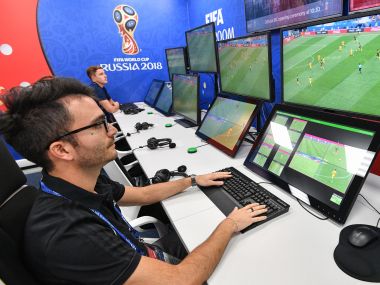With each FIFA World Cup, the game moves forward. Almost every edition of the tournament has, in one way or the other, helped the game evolve, and the upcoming edition won’t be any different. Russia 2018 will be the World Cup of Video Assistant Referee (VAR). For the first time, referees will have technology to assist them in major decisions such as penalties, red cards and goals. Confusion will reign supreme but not since 1994 has the tournament seen a change in ruling that could have such a sizable impact on the game. VAR’s readiness, however, has split the opinion of experts and fans alike. It hasn’t been welcomed by all quarters with the general consensus being that it interrupts the flow of the game and hasn’t been tested thoroughly enough to warrant its use in a competition of such significance. [caption id=“attachment_4507423” align=“alignleft” width=“380”] A view of the video assistant refereeing (VAR) operation room at the 2018 FIFA World Cup Russia International Broadcast Centre (IBC) in Moscow. AFP[/caption] It was first introduced in Australia’s A-League in April 2017 and barely a year later, VAR will be seen at a World Cup. Has it been introduced too early? Perhaps. There have been some high-profile glitches during its use in some of Europe’s top leagues, such as a supporter’s
flag covering the camera at the crucial moment in a Portuguese league match and a penalty awarded so belatedly in the German top division that the
players were recalled after a majority of them had left for the dressing room at half-time. Introduction of VAR, though, is certainly a step in the right direction for the world’s richest and most popular sport. It’s part of an evolution that we’ve seen across decades of the FIFA World Cup. Almost every World Cup has given us something new, whether this be in terms of changes to the laws of the game, format of the competition or advancement in its commercial growth. In recent years, referees have been central in FIFA’s innovations. Brazil 2014 saw the long overdue introduction of goal-line technology, albeit four years too late for England’s Frank Lampard, who was famously denied a legitimate goal against Germany. Unlike the VAR, this had a straightforward implementation and a worldwide approval. Also in Brazil, vanishing sprays became handy tools for referees to prevent player-encroachment at the time of free-kicks. The 2010 edition in South Africa, the African continent’s first, was the tournament of
Vuvuzelas — bright-coloured plastic horns that became the unofficial symbol of the event. These were loved and hated equally, sounding like an annoying swarm of bees, but they were steeped in African traditions. They took one back to Mexico of 1986, the edition that introduced the phenomenon of the ‘Mexican Wave’ to the world (apart from a phenomenon that was Diego Maradona). Today, this wave is a common sight in stadiums across the globe and among fans of multiple sports. Fan culture remains the heart and soul of the sport and FIFA has done well to take engagement with fans to a whole new level post the turn of this century. Germany 2006 gave birth to ‘Fan Fests’, inspired by
South Korea’s fanaticism on the streets in 2002. As per FIFA, over 22 million Koreans were out on the streets to watch their team play during their improbable run to the semi-finals. The World Cup became a carnival, not just inside the stadium but outside as well. In Germany 2006, the ‘Fan Mile’, stretching over a mile in Berlin, attracted an incredible 750,000-plus spectators when the host nation beat Argentina in the quarter-final. The fests became such a hit that FIFA took them to non-host cities in 2010. Along with host cities of South Africa, Sydney, Buenos Aires, Berlin, Paris, Rome, Rio de Janeiro and Mexico City held the fests. Nowadays, fans look forward to these fests as much as the matches themselves. Fan-favourite ‘World Cup Willie’ was the star of 1966, along with the England team that won the event. The cartoon lion was the first World Cup mascot and was seen as a commercial breakthrough. Each tournament since then has had a mascot: Zabivaka, the wolf, is the mascot for Russia 2018.
Click here for comprehensive coverage of FIFA World Cup 2018 Over decades, the sport has spread gradually. It is presently in its most intense expansion phase. Mexico 1970 was the first World Cup to be held outside Europe or South America. It was also the first to be televised in colour. South Korea-Japan became Asia’s maiden hosts in 2002 — it was also the first time the tournament was held in more than one country — and was followed by Africa’s maiden tournament in 2010. Russia 2018, Qatar 2022 and possibly Morocco 2026 (bid result awaited) will be more feathers in FIFA’s cap as far as spreading the game goes. Even participation of teams is on the rise — though not to everyone’s approval. The 2026 edition will see participation from 48 nations, 28 years after the World Cup expanded from 24 to 32 teams for France 1998. A few years further back, Spain 1982 was the watershed event, which saw teams increase from 16 to 24 to accommodate more Asian and African nations. The format of the World Cup and the laws of the game have undergone significant changes through the tournament’s journey. Italy 1990 is one infamous event that changed the complexion of football. It is remembered for defensive and negative tactics along with hosting, what is widely acknowledged as, the worst final in history. It forced FIFA to tweak its laws. Not only was the back-pass rule introduced in 1992 to prevent teams from wasting time by passing it back to the goalkeeper, even the points system was changed to encourage attacking play: three points for a win, instead of two. As a consequence, USA 1994 witnessed a lot of change.
Click here to view the full schedule of FIFA World Cup 2018 Twenty years earlier, Mexico 1970 had introduced red cards and yellow cards. The tournament also allowed up to two substitutions per match per team (which rose to three before the 1998 World Cup). Before 1970, only an injured goalkeeper and one injured outfield player could be replaced. Penalty shootouts were introduced, although not used, in Argentina in 1978, the tournament known more for its political undertones. Prior to that, tied matches in the knockout stages were decided by extra time or a replay. Even the teams tied for second and third positions in the group in 1958 were slated to play a replay. The ‘Golden Goal’ rule, which awarded a victory to the first team to score in extra time, only lasted the 1998 and 2002 World Cups. It was subsequently replaced by the ‘Silver Goal’ rule, which decided the 2014 World Cup final in favour of Germany. History says that football will get it right. It will learn and it will evolve. Only time will tell how the VAR will be received in Russia. Either way, the game will move forward. As it always does.
Only time will tell how the VAR will be received at the FIFA World Cup in Russia. Either way, the game will move forward, as it always does.
Advertisement
End of Article


)

)
)
)
)
)
)
)
)



